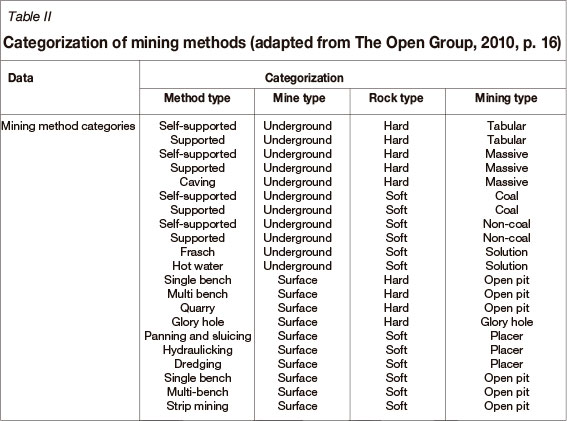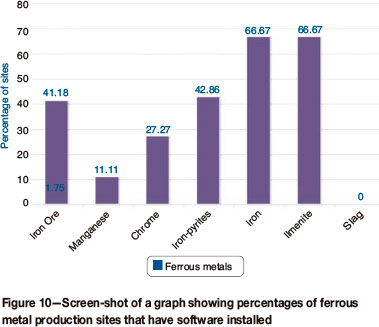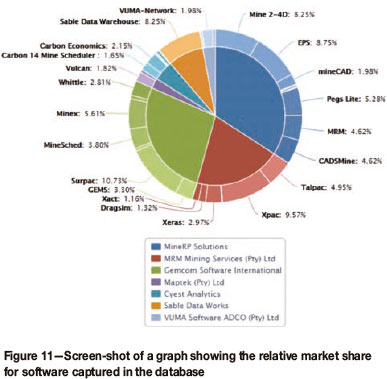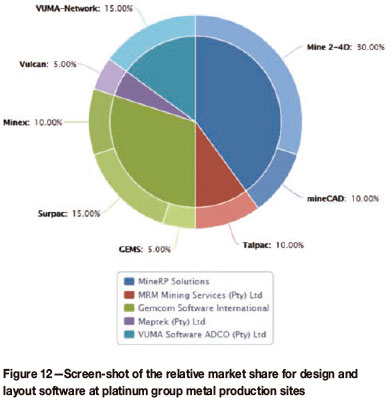Services on Demand
Article
Indicators
Related links
-
 Cited by Google
Cited by Google -
 Similars in Google
Similars in Google
Share
Journal of the Southern African Institute of Mining and Metallurgy
On-line version ISSN 2411-9717
Print version ISSN 2225-6253
J. S. Afr. Inst. Min. Metall. vol.113 n.6 Johannesburg Jun. 2013
Online database of mine planning and peripheral software used in the South African mining industry
T.P. Katakwa; C. Musingwini; B. Genc
School of Mining Engineering, University of Witwatersrand, Johannesburg, South Africa
SYNOPSIS
The utilization of software is now inherent to virtually every activity along the mining value chain. However, apart from the software survey done by Gibbs in the 1990s and work on the extent of diffusion of information and communication technology (ICT) in the South African platinum sector by Mugodi and Fleming in 2003, the nature and extent of software utilization in the South African mining industry has never been evaluated. The Mine Planning, Optimisation and Valuation (MPOV) Research Group in the School of Mining Engineering, University of Witwatersrand, therefore initiated a project to collate and analyse the current utilization of software in the South African mining industry. This was done through the development of a web-based database of the relevant software. Snowball sampling was used to collect the data because the South African mining industry is diverse and software utilization is fragmented across and within the sectors of the industry. The data was then organized into distinct categories so that the information from a variety of sources could be evaluated on the same basis. A beta version of the database can be accessed online through a user-friendly front-end platform at http://db.mining.wits.ac.za.
The database is expected to help at least 13 educational institutions with decisions on facilities and training that are vital to the education of mining and mining-related professionals. Exploration, mining, and consulting companies will also benefit from information in the database relating to availability and useful combinations of software solutions. The database is also strategic to software providers by providing a better understanding of their respective relative market share along the mining value chain. An analysis of the data collated in this research shows that about 77% of the software users are mining companies, 17% are consulting companies, 3% are mineral exploration companies, and the rest are software providers and educational institutions. The software used in the South African mining industry is largely provided by Gemcom Software International, MineRP Solutions, and MRM Mining Services. CAE Mining, who in 2010 acquired the Datamine Group providing Datamine software, is also widely acknowledged as a major software supplier in South Africa, but data from them had not been obtained at the time of producing the beta version of the database due to proprietary constraints. The work reported in this paper is part of an MSc research study in the School of Mining Engineering at the University of the Witwatersrand.
Keywords: mine planning, mining, value chain, software, database, South African mining industry, utilization.
Introduction
The mining industry, like many other industries, uses computers and common software such as Microsoft Office®, for routine administrative tasks. However, the industry also uses a range of applications that are specific to mining where the computer speed, accuracy, and ability to cope with large volumes of data present the opportunity for optimal solutions to mine planning decision-making problems. In mining, computer applications are generally used to assist engineers in the day-to-day decision-making process by simplifying the process of storage, retrieval, and analysis of data from mining operations as well as facilitating the design, simulation, and monitoring of mine plans (Badiozamani, 1996). The adoption of computers and rapid growth of computer usage in most industries can be attributed to the fact that the cost of computer equipment has dropped drastically over the years, and continues to drop while computer efficiency has been improving. For example, computer prices fell by 90% over the period 1998 to 2008 (Perry, 2009) and during the same period computer performance doubled almost every 1½ to 2 years (Koomey et al., 2009). In addition, software providers are also competing to help mining companies extract minerals in the most profitable manner, resulting in a proliferation of software utilization in the mining industry (Binning, 2009). Ever since their adoption in the mining industry, computers have played a significant role towards achieving higher mining rates and better utilization of resources in order for the industry to remain competitive.
It is now commonplace that, due to the adoption of and rapid growth in the utilization of software, mine planning and peripheral software has become an inherent part of virtually every activity along the mining value chain. However, the nature and extent of the software utilization in the South African mining industry has never been evaluated. Surveys were conducted in the 1990s to ascertain hardware and software utilization in the mining industry, and about 6% of the responses came from South Africa (Gibbs, 1999). However, these results, obtained more than a decade ago, are not very useful in ascertaining the current state of the utilization of software the mining industry in South Africa. More recently, a study of the diffusion of information and communication technology (ICT) into the South African platinum mining sector was conducted by Mugodi and Fleming (2003). The Mugodi and Fleming study is limited because it focused on the adoption of computer technology in only one sector of the industry, and therefore is not very useful for understanding the utilization of computers applications across the entire South African mining industry. In contrast, the database of mine planning and related software is more holistic because it collates data relating to software utilization over the entire mining sector. This paper introduces the concept of the database and presents the baseline results obtained. The work reported in this paper is part of an MSc research study in the School of Mining Engineering at the University of the Witwatersrand.
Rationale for developing an online database and choice of scripting language
In order to evaluate the nature and extent of mine planning and related software utilization, a researcher would traditionally be expected to take a statistically significant sample and draw inferences therefrom. However, when considering the fact that the mining industry is diverse and software utilization is fragmented across and within the sectors of the mining industry a database would be an ideal choice for collating data from the intended population. When data is included from as much of the population as possible, the conclusions that can be drawn from the analyses will not be based on expert judgement alone but also on the intended population. Since a database can be designed to categorize the data and show the relationships between the categories to facilitate data analysis, the online database combines the advantages of traditional sources of information with the advantages presented by the internet. In addition, the intended beneficiaries of information on mine planning and related software utilization in South Africa are varied and located over a large geographical area. For this reason it was imperative to deploy the database online. This has the advantage of transmitting information around the world, and which is easily accessible to those who have an internet connection.
It was necessary to make a comparison of the technologies available in order to develop the online database. Of the server database engines that were readily available, MySQL had the distinct advantage of being platform-independent. It may be installed on a server running any operating system. In order to manipulate data and present the data in a web browser, a server side scripting language, which allows one to create dynamic web pages, was used. A dynamic web page is a page whose contents are a result of interaction with the user. The contents can change after the page has been loaded, depending on user actions, without the developer having to change the code. It is possible to connect the web page to a database that stores the information that is required to be displayed on the web page. Figure 1 is a diagrammatic representation of how a server-side scripting language produces dynamic web pages. Of the server-side scripting languages, the Personal Home Pages (PHP) hypertext programming language was chosen for this project. The following advantages offered by PHP, as articulated by Rakesh (2011), influenced its selection for this project:
PHP is stable and secure because it is capable of developing powerful web applications that are scalable up to a very large number of users. PHP is stable and secure, and robust enough for business-critical applications needing constant up-time and high security
PHP allows rapid and easy deployment because it is easy to understand and learn. In addition there are development frameworks such as QCubed that separate business logic from the user interface, resulting in cleaner and reusable code
PHP comes at no cost because it is freeware
PHP is portable across different operating systems
PHP allows database integration by including the ability to connect directly to a Structured Query Language (MySQL) database, which removes the additional overhead when using Open Database Connectivity
PHP is supported by a vibrant community, estimated to consist of about 5 million developers that share code, evangelize about PHP, and support each other to improve the language and increase its capabilities.

Development phase and database structure
Three parallel tasks were carried out to achieve the objectives of this project:
Gathering and categorizing the data required
Developing a database for storing, retrieving, and manipulating the data
Developing an application for accessing the data and analysing it.
In view of the fact that the mining industry is diverse and software utilization is fragmented across and within sectors of the industry, effort was made to gather as much data as possible from existing databases, conferences, and other sources. Consulting and exploration companies were identified on the Global InfoMine website (http://www.infomine.com). Information about mining companies was obtained from the Department of Mineral Resources website (http://www.dmr.gov.za). It includes a full list of operating mines, quarries, and processing plants during the year 2010. Software providers and software users were identified using web directories and other sources. These were subsequently approached in order to hold expert interviews, administer questionnaires where possible, and assist in identifying key players in the industry to be included in the database. This non-random sampling approach, called 'snowball sampling', meant that effort was expended to evaluate the intended population. Gray (2009) explained that with snowball sampling, the researcher identifies a small number of subjects, who in turn identify others in the population who can also provide leads to remaining parts of the population. By following this approach it may be possible to eventually reach every subject in the intended population.
The data collected was modelled into different entities. An entity type is a group of objects with the same properties. Each entity type has one or more properties or characteristics. These are called attributes. The associations among entity types were modelled as relationships. It was then possible to build a conceptual data model of the database. Figure 2 depicts a simplified conceptual model of the mine planning and peripheral software database. In the diagram, the symbol '♦' denotes that exactly one entity type instance exists at the association end, while the symbol '·' is used to denote that zero, one, or more entity type instances exist at the association end. Tables I and II summarize the categorizations that were made for some of the entities to facilitate data analysis.


In the implementation design phase for the database, the conceptual data model was translated into a 'logical' representation of the database system. The following translations were made:
Entity types became tables
Attributes became fields or columns
Relationships between entity types became foreign keys.
Structured Query Language (SQL) was used to create these objects and insert data into the database.
A web-based interface for accessing and analysing the data in the database was developed. The nature of the web application for the mine planning and peripheral software database required the adoption of the hierarchical and networked structures as illustrated in Figure 3. This design allows the user to follow along a vertical branch of the hierarchy. At the same time the user may navigate horizontally across branches. A pattern that guides a user through a series of options in order to direct the user to specific content indicated by the sequence of options chosen or decisions made was used. The web pages were made as uniform as possible in order to allow a user to have consistent navigation guidance regardless of location within the web application. The system is designed to help the user to find information specific to a certain category, company, or software and then drill down to lower levels of detail without losing the 'look and feel' of the website.

Using a PHP framework called Qcubed helped to speed up the process of developing the website and reduce the amount of code that had to be written for common tasks. Highcharts is a charting library based on a client-side scripting language called Javascript. PHP data classes were used to extract arrays that were used in conjunction with the Highcharts library to produce the graphs for displaying software adoption, market share, and other analyses. Figure 4 shows the home page of the mine planning and peripheral software database, while Figure 5 illustrates the ease with which the web pages or tabs can be navigated in the database. The website is available online at http://db.mining.wits.ac.za.


Database functionality
The web site is compatible with popular web browsers such as Internet Explorer, Google Chrome, Mozilla Firefox, and Opera Safari, running on any operating system. The graphical interface is easy to follow and requires no formal training. The mine planning and peripheral software database offers the following functionalities:
Data storage - the system stores information about companies, related sites, and software installed at those sites. The software is categorized with respect to its functionality and related mineral commodities and mining methods. Companies are related as to whether they are developers, suppliers, or clients of software
Data access - the system provides a main page which anyone surfing the web will be able to access. This page allows any user to browse to or search for basic information on companies and software
Summary information - the system has a menu providing options such as Analyse market share, Analyse software adoption, Analyse client distribution, and Compare solutions available for a certain mine value chain stage
Access levels - the system allows users to have different levels of privileges. A 'login' facility is provided to allow privileged users access to more advanced functionalities of the system. While all users can access all the summary information, only the privileged users are able to view confidential data and to enter or update the data, depending on the privileges granted to them.
Baseline results
Companies that provided data which is captured in the database were consulted to ascertain the validity of the captured data in order to assure integrity of the database. This was done over a period of three months before the database went live.
On browsing to the 'Search' tab on the web-based interface, a user is presented with a set of criteria for searching through the database for available software captured in the database. Figure 6 shows a screen capture of the output from the database showing the functionalities of specific software along the mining value chain. The last column in Figure 6 on virtual reality (VR) simulation software is blank because VR is a fairly recent concept in the South African mining industry. The VR software system uses interactive computer game-style training modules with highly immersive audiovisual environments. VR has found acceptance in a number of industries as an effective method of training for a variety of workplace activities, including those of a safety related nature. Different VR applications are now available for both surface and underground mining operations for machine operators. In most cases VR applications are used in conjunction with traditional training methods and have proven to improve health and safety as well as productivity of the mineworkers. As part of future work, it is planned to add VR software utilization into the database and also extend the database to include the broader southern African region.

On the 'Analysis' tab, one can use the different options to analyse the:
Distribution of commodities at mining sites
Adoption of software at mining sites
Relative market share based on the criteria selected
Distribution of clients by company profile for the different providers.
The screen-shots illustrated in Figures 7 to 12 show examples of output that can be obtained from the database based on the criteria selected under the 'Analysis' tab. For example, in Figure 7 it can be seen that about 77% of the software users are mining companies, 17% are consulting companies, 3% are mineral exploration companies, and the rest are software providers and educational institutions. A few software providers also fall into the category of 'user' because some mining companies contract some of the mining value chain activities to software providers. Figure 8 shows that platinum group metal (PGM) sites lead precious minerals in terms of software adoption, with 52.7% of PGM sites having software installed. Figure 9 shows that uranium sites are leading the energy minerals, with 55% of uranium sites having software installed. Figure 10 illustrates that in the ferrous and related mineral category, sites at which iron is mined lead in software installations at 66.67% of sites having software. Figure 11 is a pie chart representation of the relative market share of software products along the entire mining value chain, indicating that MineRP Solutions, Gemcom Software International, and MRM Mining Services (Pty) Ltd are the leading software suppliers to the South African mining industry. However, once data for CAE Mining, who in 2010 acquired the Datamine Group providing Datamine software, is acquired and included in the database, the relative market shares will change. Lastly, Figure 12 indicates that for PGM sites at the mine design and layout stage of the mining value chain, MineRP Solutions and Gemcom Software International provide the predominant software products. Again, this distribution will change once data from CAE Mining is acquired and included in the database.






Relevance of the database
The online database is expected to help educational institutions with decisions on facilities and training vital to the education of geologists, surveyors, mining engineers, and other professionals who are involved in planning across the mining value chain. This database is expected to complement work that is being done to address the challenge of skills shortage in the country by that ensuring that graduates have been exposed to commonly used software in mine planning and other activities peripheral to mine planning. The Southern African Institute of Mining and Metallurgy (SAIMM) established a Mine Planning and Design Industry Forum which is involved in various initiatives to promote skills development in the field of mine planning (Macfarlane, 2012). In Canada, a project named MineDesignWiki is being carried out to compile mine design knowledge over a broad range of topics (Lyle, McKinnon, McIsaac, and Dasys, 2011). The result will be a workbook using a web-based Wiki-type framework. It is designed to ensure reliability of information content through author attribution and formalized peer review. A database such as the one presented in this paper can complement the MineDesignWiki initiative by providing information on software solutions that are commonly used for mine planning.
It is expected that exploration, mining, mineral processing, and consulting companies will benefit from the database information relating to availability of software solutions. The database is also expected to help companies that may wish to set up mineral resource management departments or keep track of developments in the sector in order to make informed decisions. The database will also enable software providers to have a better understanding of the extent of software utilization in the mining industry and their respective relative market share along the mining value chain.
Conclusion
This paper presented a methodology for evaluating the nature and extent of mine planning and peripheral software utilization in the South African mining industry by developing a database of the software and deploying the database online. This in itself reflects a new way of seeking to answer similar research problems in other countries. Since the database is deployed online it ceases to be purely of academic interest, and its results are accessible to a wider audience. Professionals in the mining industry may access the database and extract relevant information that is useful in decision-making for their respective specialities. A database that is capable of capturing information from the intended population and has the potential to be updated over time is a powerful tool for exploring other research questions. The database is designed in such a way that it can be extended to include additional modules on other data categorizations and time trend analysis post-2012. Using this research project as a starting point, work on a thesis investigating strategies for the optimal utilization of mine planning software has commenced in the School of Mining at the University of the Witwatersrand. It is hoped that the acceptance of the significance of this project is sustained from now on, and that the database benefits the current and future generations of mining industry professionals.
Acknowledgements
The input from individuals associated with Maptek, MineRP, Gemcom Software, MRM Mining Services, Cyest Analytics, SABLE DataWorks and VUMA Software ADCO who facilitated the provision of data used in this project is gratefully acknowledged. The authors would particularly like to acknowledge assistance provided by Mr. Mike Woodhall (Vice President Growth, MineRP Africa (Pty) Ltd, a subsidiary of Gijima Holdings).
References
Badiozamani, K. 1996. Computer methods. SME Mining Engineering Handbook. Society for Mining, Metallurgy and Exploration (SME), Colorado. pp. 598-626. [ Links ]
Binning, D. 2009. ERP: Software-Salvation. http://www.mining-technology.com/features/feature70532/ [Accessed 3 February 2011] [ Links ].
Gibbs, B.L. 1999. What the mining industry wants from technical software. Mining Engineering, March 1999. Society for Mining, Metallurgy and Exploration (SME). pp. 33-38. [ Links ]
Gray, D.E. 2009. Doing Research in the Real World, 2nd edn. Sage Publications, London, UK. [ Links ]
Khan, K. 2012. Introduction to PHP. http://www.webkollage.com/php_introduction.php [Accessed 26 July 2012] [ Links ].
Koomey, J.G., Belady, C., Patterson, M., Santos, A., and Lange, K. 2009. Assessing trends over time in performance, costs, and energy use for servers. http://www.intel.com/assets/pdf/general/servertrendsreleasec-omplete-v25.pdf [Accessed 16 March 2011] [ Links ].
Lyle, G.D., McKinnon, S.D., McIsaac, G.J., and Dasys, A.A. 2011. The use of a wiki format to compile mine design knowledge - what's in it for you? Strategic versus Tactical Approaches in Mining 2011. Australian Centre for Geomechanics, Perth, Australia. pp. 267-273. [ Links ]
Macfarlane, A. 2012. Mine planning and design qualifications. http://www.saimm.co.za/news/204-mine-planning-and-design-qualifi-cations?format=pdf [Accessed 22 June 2012] [ Links ].
Mugodi, T.Z. and Fleming, D.R. 2003. A study of ICT diffusion into South Africa's platinum mining sector. Application of Computers and Operations Research in the Mineral Industries. Southern African Institute of Mining and Metallurgy (SAIMM). pp. 505-509. [ Links ]
Perry, M.J. 2009. Computer prices have fallen by 90% over the last ten years: is that evidence of monopoly power? http://mjperry.blogspot.com/2009/05/computer-prices-have-fallen-by-90-over.html [Accessed 16 March 2011] [ Links ].
Rakesh 2011. Why choose PHP for enterprise web development? http://php.osscube.com/blog/why-choose-php-enterprise-web-development [Accessed 8 September 2011] [ Links ].
The Open Group. 2010. The exploration and mining business reference model. https://collaboration.opengroup.org/emmmv/documents/22706/ Getting_started_with_the_EM_Business_Model_v_01.00.pdf [Accessed 21 June 2012] [ Links ].
Paper received Aug. 2012
Revised paper received Feb. 2013
© The Southern African Institute of Mining and Metallurgy, 2013. ISSN 2225-6253.














